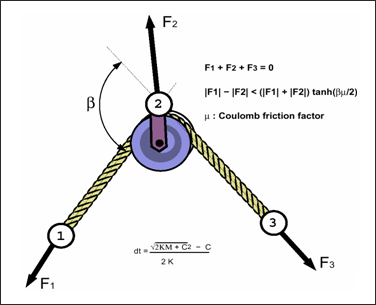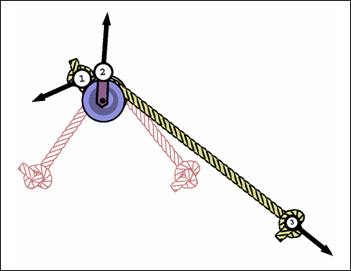Pulley (/PROP/SPR_PUL) |

|

|

|

|
|
Pulley (/PROP/SPR_PUL) |

|

|

|

|
Spring type 12 is used to model a pulley. When used in a seat belt model, it is defined with three nodes. Node 2 is located at the pulley, and a deformable rope is joining the three nodes (Fig. 3.7). The spring mass is distributed on the three nodes with ¼ at node 1 and node 3 and ½ at node 2.
A Coulomb friction can be applied at node 2, taking into account the angle between the two strands. Without friction, forces are computed as:
![]()
with, ![]() being the total rope elongation and K being the stiffness. If the Coulomb friction is used, forces are corrected:
being the total rope elongation and K being the stiffness. If the Coulomb friction is used, forces are corrected:
F = K (![]() 1 +
1 + ![]() 2)
2)
![]()
![]()
![]()
F2 = -F1 - F3
![]() 1 is the elongation of strand 1-2 and
1 is the elongation of strand 1-2 and ![]() 2 of strand 2-3.
2 of strand 2-3.

Fig. 3.7: Spring type 12, pulley
Time step is computed with the same equation that for spring type 4; but the stiffness is replaced with twice the stiffness to ensure stability with high friction coefficients.
|

Fig. 3.8: Spring type 12, locking
For further information, refer to the RADIOSS Theory Manual.